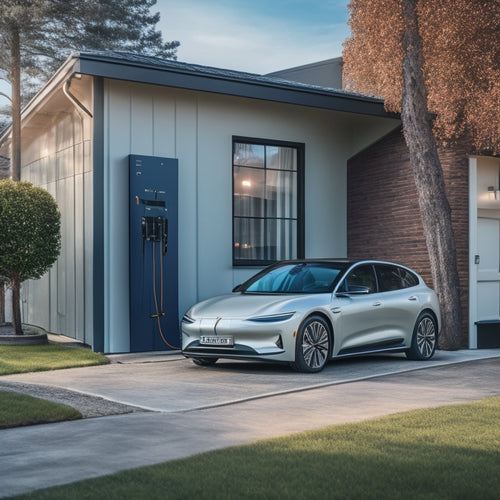
Installing Electric Panels on Your Roof: Key Considerations
Share
When installing electric panels on your roof, you're not just adding a renewable energy source - you're integrating a complex system that requires careful consideration of your roof's size, condition, and structural integrity, as well as local building codes and permits. You'll need to assess your roof's size and condition to determine installation feasibility, evaluate shading and orientation for ideal energy production, and choose the right panel type for your energy needs and budget. Additionally, you'll need to verify your roof can support the added weight and comply with local regulations, and by doing so, you'll be well on your way to a successful installation that meets your renewable energy goals.
Key Takeaways
- Assess your roof's size, condition, and insulation to determine feasibility and optimal panel placement for efficient energy production.
- Evaluate shading and orientation by considering solar access, roof pitch, and angle to maximize sunlight exposure and energy generation.
- Choose the right panel type based on efficiency, cost, and energy needs, considering monocrystalline, polycrystalline, and thin-film options.
- Ensure structural integrity by evaluating roof load distribution, panel weight, and material durability to support the additional weight of panels.
- Comply with local building codes and obtain necessary permits by researching regulations, preparing detailed plans, and hiring licensed professionals if required.
Roof Size and Condition Matter
Your roof's size and condition are vital factors to take into account when installing electric panels. A larger roof provides more space for panel placement, but it also increases the complexity of the installation. On the other hand, a smaller roof may limit the number of panels you can install, but it's often easier to manage.
Additionally, your roof's condition plays a significant role in determining the feasibility of the installation. If your roof is old or damaged, you may need to replace it before installing electric panels.
Proper roof insulation is also essential to guarantee the panels operate efficiently. Insulation helps to regulate the temperature, reducing the risk of overheating and maximizing energy production.
When evaluating your roof's condition, consider factors such as age, material, and structural integrity. A thorough evaluation will help you determine the best approach for your electric panel installation.
Assessing Shading and Orientation
Beyond roof size and condition, evaluating shading and orientation is essential to secure peak electric panel performance.
You'll want to assess the amount of solar access your roof receives throughout the day. Obstructions like trees, buildings, or even skylights can cast shadows, reducing panel efficiency.
Take note of the direction your roof faces, as south-facing roofs typically receive the most sunlight. If your roof has multiple orientations, you may need to adjust panel placement accordingly.
Consider the time of year and how the sun's position changes. During winter, the sun is lower in the sky, while in summer it's higher. This affects the amount of sunlight your panels receive.
You'll also want to evaluate the pitch and angle of your roof, as this can impact panel installation and performance. By understanding these factors, you can optimize panel placement to maximize energy production.
Choosing the Right Panel Type
With your roof's shading and orientation assessed, it's time to select the ideal electric panel type for your installation.
You'll want to take into account factors such as panel efficiency, installation costs, and your specific energy needs.
When evaluating panel types, you'll encounter monocrystalline, polycrystalline, and thin-film panels.
Monocrystalline panels boast the highest efficiency rates, but come at a higher cost.
Polycrystalline panels offer a balance between efficiency and affordability, while thin-film panels are the most budget-friendly option, but with lower efficiency rates.
Reflect on your energy requirements and budget to determine the best panel type for your installation.
If you have limited roof space, high-efficiency panels may be the best choice.
However, if budget is a concern, polycrystalline or thin-film panels might be a more suitable option.
Assessing the pros and cons of each panel type will guarantee you make an informed decision and maximize your solar energy potential.
Ensuring Structural Integrity
Before installing electric panels on your roof, you must guarantee the structure can support the added weight and stress. This means evaluating your roof's load distribution to confirm it can handle the extra load of the panels.
You'll need to take into account factors such as the panel's weight, size, and placement, as well as the roof's material durability and age.
A thorough inspection of your roof's underlying structure is vital. Check for any signs of wear, damage, or weakness, including rotten wood, rusted flashing, or compromised roofing materials.
Verify that your roof's framing, decking, and underlayment are in good condition and can withstand the additional weight and stress.
It's also essential to take into account the material durability of your roof's components, including the panels themselves, flashing, and fasteners.
Choose high-quality materials that can withstand the elements and last for years to come.
Local Building Codes and Permits
You'll need to comply with local building codes and obtain necessary permits before installing electric panels on your roof. This guarantees your installation meets safety standards and adheres to zoning regulations.
Failure to do so can result in fines, penalties, or even removal of the system.
Research your local government's website or consult with your local building department to determine the required permits and fees. These fees can vary depending on your location and the type of installation.
Be prepared to provide detailed plans and specifications of your electric panel installation, including the type and number of panels, inverters, and mounting systems.
Additionally, you may need to hire a licensed electrician or contractor to perform the installation, as they're often required to obtain permits and inspections on your behalf.
Factor in the installation fees and timeline into your overall project plan to avoid delays or unexpected costs.
Frequently Asked Questions
Can I Install Electric Panels on a Metal or Clay Tile Roof?
You'll face unique installation challenges with metal or clay tile roofs, but it's not impossible; you'll need to confirm the roof material's suitability by evaluating its structural integrity and potential for water damage before proceeding with electric panel installation.
How Often Should I Clean My Roof-Mounted Electric Panels?
Did you know 95% of dirty solar panels experience a 25% power loss? You'll want to clean your roof-mounted electric panels every 6-12 months to maintain ideal energy output; use a soft-bristled brush, mild soap, and distilled water for effective cleaning and minimal maintenance.
Are There Any Special Warranties for Roof-Mounted Electric Panels?
You'll want to verify your roof-mounted electric panels come with special warranties that align with the installation guidelines, providing extensive warranty coverage for your investment, giving you peace of mind and protection against manufacturing defects and performance issues.
Can I Install Electric Panels Myself to Save on Labor Costs?
You're considering a DIY installation to save on labor costs, but it's essential you're aware of the safety regulations involved; without proper training and knowledge, you might compromise the system's performance and your own safety.
Do Roof-Mounted Electric Panels Affect My Roof's Warranty?
You're wise to contemplate the roof warranty implications; when you install roof-mounted electric panels, you'll need to follow the manufacturer's roof installation guidelines to avoid voiding your warranty, ensuring a safe and compliant installation that meets industry standards.
Conclusion
As you prepare to install electric panels on your roof, remember that it's a puzzle with many interconnected pieces. Confirm the roof size and condition are suitable, assess shading and orientation, choose the right panel type, and secure structural integrity. Don't forget to steer through local building codes and permits. With all these factors in harmony, your solar panel system will shine like a guiding light, generating clean energy and saving you money.
Related Posts
-

5 Essential Tips for Buying EV Charging Systems Online
When purchasing an EV charging system online, you'll want to make sure you're making an informed decision. First, det...
-

Top 10 DIY Conversion Kit Reviews and Tips
You're taking the first step towards electrifying your ride, and with the right DIY conversion kit, you'll be cruisin...
-

7 Ways to Save on Residential Home Solar Panels
You can save thousands on your residential home solar panels by leveraging financial incentives, dealer offers, and s...


